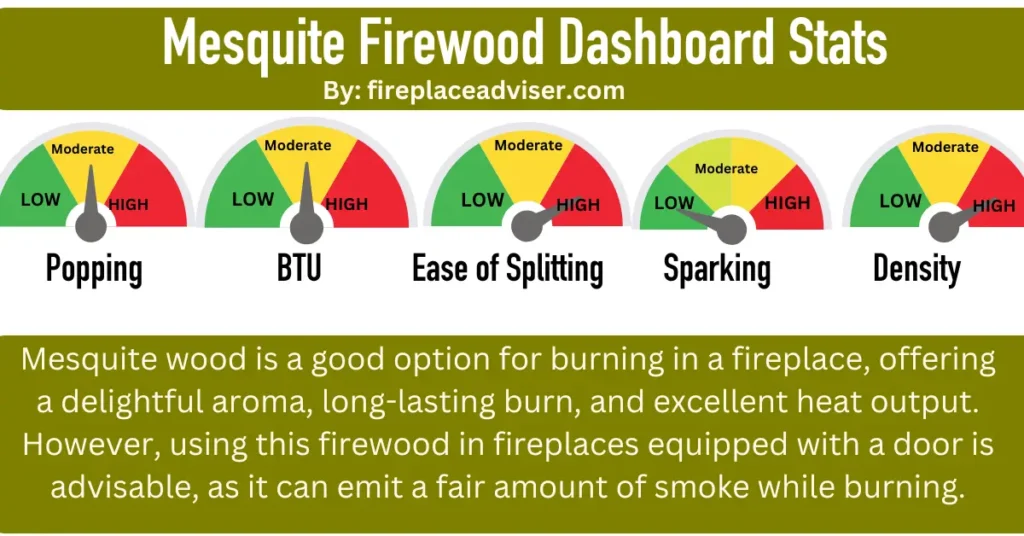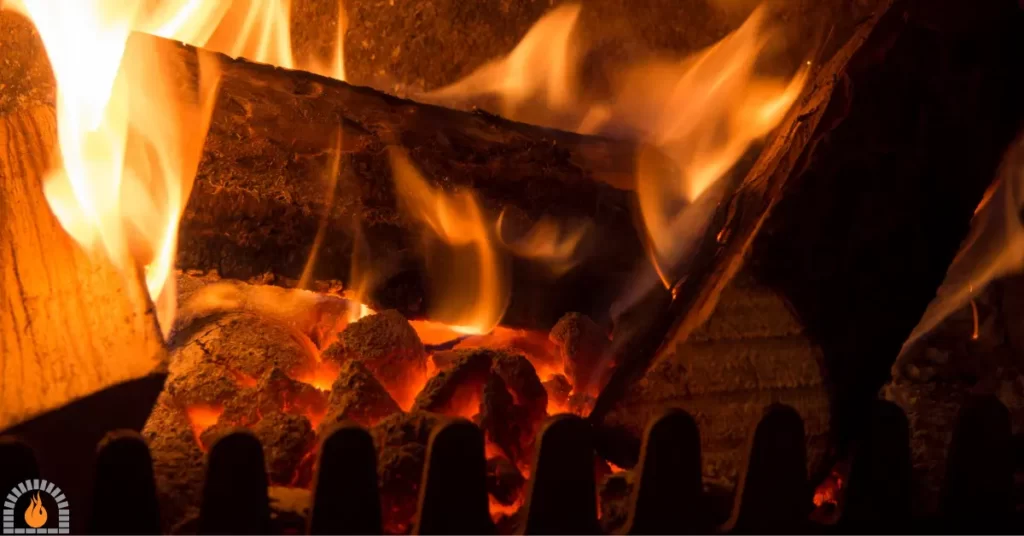Mesquite is a dense hardwood native to the Southwestern United States and other arid regions. It is known for its hardness, durability, and distinctive aroma, making it a popular choice for grilling and smoking in outdoor cooking. However, several factors must be considered when considering using Mesquite in a fireplace.
- Question: Can You Burn Mesquite in a Fireplace?
- Answer: Yes, Mesquite wood is a good option for burning in a fireplace, offering a delightful aroma, long-lasting burn, and excellent heat output. However, using this firewood in fireplaces equipped with a door is advisable, as it can emit a fair amount of smoke while burning.
| Heat per Cord (Million BTUs) | 28.0 |
| Smoke | Moderate |
| Spark | Less |
| Ease of splitting | Hard |
| Aroma | Pleasent |
| Coaling | Moderate |
| Creosote Buildup | High |
Can You Burn Mesquite in a Fireplace?
Yes, you can burn mesquite wood in a fireplace. Mesquite wood is commonly used as a source of firewood for fireplaces, wood stoves, and outdoor fire pits due to its desirable burning characteristics. It produces a hot and long-lasting fire with a pleasant aroma.
However, it’s essential to note that using any wood in a fireplace requires certain precautions to ensure safe and efficient burning:
- Use well-seasoned mesquite wood that has been properly dried for at least six months. Seasoned wood burns more efficiently, produces less smoke, and reduces the risk of creosote buildup in the chimney.
- Avoid burning wood that has been treated or painted, as these materials can release harmful fumes into the air and create hazardous by-products.
- Ensure your fireplace has adequate ventilation to allow for proper airflow and prevent the buildup of smoke inside your home.
- Regularly clean and inspect your fireplace to prevent creosote buildup and reduce the risk of chimney fires.
- Check with local authorities or your homeowner’s association for any restrictions or regulations regarding fireplaces and the type of wood that can be burned.

Pros of Mesquite Firewood
- High heat output
- Aromatic fragrance
- Long-lasting burn
- Ideal for grilling and smoking
- Minimal ash residue
- Widely available
- Beautiful wood grain
- Low moisture content
Cons of Mesquite Firewood
- Slow burning
- Hard to split
- Produces Moderate smoke
- Difficulty in ignition
- Creates intense heat
- Not environmentally sustainable
- Prone to sparking (Un-Seasoned)
- Can impart strong flavor
- Expensive in some regions
Mesquite Firewood Characteristics
Calorific Value and Heating Efficiency
One of the essential factors in choosing firewood is its calorific value, which determines its heating efficiency. Mesquite, with its high density, provides an excellent heat output, making it a potentially efficient choice for heating.
However, its density also means it burns slower, which may lead to longer burn times than softer woods.
Sparks and Embers
Dry and seasoned mesquite firewood generally produces minimal sparks, allowing you to enjoy sitting around a campfire outdoors without constantly ducking from embers.
However, green woods tend to generate more sparks, potentially causing inconvenience.
Smoke
Mesquite is renowned for emitting a significant amount of smoke during combustion. Seasoning plays a crucial role when using any type of wood, including mesquite.
Green wood contains moisture that results in excessive and undesirable smoke.
Creosote Buildup
Creosote, a byproduct of wood combustion, gradually accumulates in the chimney and flue over time. When burning Mesquite, the risk of creosote buildup increases due to its slower burn rate and potential for incomplete combustion.
It’s crucial to understand that creosote is highly flammable, and neglecting regular cleaning can lead to chimney fires and chimney tapping sound.

Best Practices for Burning Mesquite Wood
Is Mesquite good firewood? If you choose to burn Mesquite in your fireplace, follow these best practices to ensure safety and efficiency:
- Properly season mesquite wood for at least six months to reduce moisture content and improve burn quality.
- Stack the wood in a way that allows air circulation to facilitate drying and reduce the risk of mold growth.
- Use Mesquite as a supplemental wood rather than the primary fuel source, mixing it with other hardwoods to mitigate its potential drawbacks.
- Invest in a spark screen or fireplace doors to contain sparks and embers.

Alternative Fireplace Wood Options
Considering the potential challenges of burning Mesquite, exploring alternative firewood options is wise. Some excellent firewood alternatives include oak, maple, cherry, and hickory, which offer good heating efficiency and minimal spark production.
Our Message: Environmental Considerations
While Mesquite is abundant in some regions, using it as firewood raises concerns about sustainability. Overharvesting Mesquite for firewood can lead to deforestation and disrupt natural ecosystems.
It is essential to consider alternative, more sustainable options to preserve the environment.
Read More:
FAQ
Can you burn mesquite wood in a wood stove?
Yes, you can burn mesquite wood in a wood stove. Mesquite wood is commonly used as a fuel source for wood stoves and fireplaces due to its high heat output and pleasant aroma. It burns hot and produces a smoky flavour, often used for barbecuing and smoking meats.
Is mesquite smoke bad for you?
As for whether mesquite smoke is bad for you, any type of wood smoke, including mesquite, can release harmful pollutants and particulate matter into the air when burned. Inhaling these pollutants can harm your health, especially for individuals with respiratory conditions, such as asthma or chronic obstructive pulmonary disease (COPD). Prolonged exposure to wood smoke may also be associated with other health issues.
Is mesquite the same as charcoal?
No, mesquite is not the same as charcoal. They are two different things.
My Final Thoughts: Can You Burn Mesquite in a Fireplace?
In conclusion, while burning Mesquite firewood in a fireplace is possible, it comes with challenges and risks. Mesquite’s density and slow burn rate can provide a high heat output, but it also produces more sparks and increases the risk of creosote buildup.
To ensure a safe and enjoyable fireside experience, using Mesquite as a supplemental wood paired with other hardwoods is advisable.
Alternatively, exploring more sustainable and less hazardous firewood options can improve your fireplace experience and contribute to environmental conservation.
Stay warm and safe by making informed choices regarding your fireplace wood selection.
Affiliate Disclosure: Fireplaceadviser.com is a participant in the Amazon Services LLC Associates Program. We may earn a commission when you click on certain links on this site and purchase.

Hello!! I am Jamal Khan. I often fix my home electric heaters and gas stove problems and research the common issues in the heating units to improve my knowledge and expertise. The aim of establishing fireplaceadviser.com is to share my expertise and knowledge with my audience.











